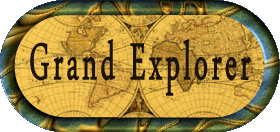This morning when I opened the drapes what I saw was fog but luckily it was not cold, about 60 degrees so that was good and again I was greeted with little ducks outside my window. After a full breakfast of smoked salmon, scrambled eggs with bacon and some strong coffee I was all set to face another exciting day.
Rudesheim is located in the heart of the Rhine river area at the southern entrance to the Lorelei valley, about 50 miles from Frankfurt. It is one of Germany's most Romantic cities to visit as it lies along the Rhine River decorated with an abundance of castles. This area on the Rhine is the narrowest and deepest part of the Rhine and this stretch of the river has about 40 castles and fortresses going back to the 1600's around the Thirty Years' War period.
To reach the center of town we traveled on a quaint little train which took a mere 10 minutes to reach our destination. Good food and music is everywhere. The Drosselgasse is a great place to eat and listen to some ump pa pa music. You can actually hear the music throughout the streets because it carries so far. The paths along the streets are narrow, but it's not a problem because everyone seems so happy to be there even on a foggy day.
Rudesheim, is at the foot of the Taunus Mountains and is a chief centre of the Rhine wine industry. It was first mentioned in 864. The Bromserburg, an early castle of the archbishops of Mainz, was rebuilt as a residence about 1200 and later belonged to the knights of Rudesheim; it now houses historical collections and a wine museum. Half-timber houses, narrow streets, and old inns give the town a medieval character. At the top of the Niederwald Height is a monument commemorating the founding of the German Empire in 1871. Rudesheim is also known for its brandy and Sekt, a sparkling white wine. Its location, architecture, and wines make the town a favoured stop along the Rhine for tourists.
This town is very quaint with many small alleyways and cobbled-stoned walkways leading to many cafes and shops which sell beautiful items including their wonderful wines. Germany is also well known for its hand crafted miniatures. Since I have a miniature dollhouse I was intrigued to visit one of the small shops offering German made items and I was happy to find a beautiful armchair and a miniature porcelain German beer stein
After some free time in the town for sightseeing and shopping we headed back to the ship for lunch.
In the afternoon we had an excursion for a wine tasting at the Schloss Vollrads Castle. The Estate’s landmark is the powerful tower. It was built on top of roman ruins and is surrounded by an idyllic pond. The Estate had been the Greiffenclau residence since the 14th century from where they had been managing the Castle as well as the Wine Estate. Its charming location in the midst of a beautiful countryside.
Schloss Vollrads is one of the oldest Wine Estates in the world. Wine sales have been documented as early as 1211 and ever since. Schloss Vollrads is surrounded by easy walking paths, a nature trail through the vineyards, and the Schloss Vollrads forest which is a nature reserve.
We tasted several great Reisling wines produced on the estate and had a chance to visit the castle with it's many elaborate rooms. In 1684 the present two-winged manor house was built by Georg Phillip Greiffenclau von Vollrads near the tower. His son Johann Erwein erected the estate buildings around 1700, as well as boundary walls around the manor garden, and finally equipped the tower with a typical baroque roof.
In 1975 Erwein Matuschka Greiffenclau took charge of the property, which was heavily in debt. Although an important figure in the emergence of a new or rediscovered style of high quality dry Rheingau wine in the 1980s and 1990s, he was not successful in reorganising his estate.
When in 1997 the principal bank decided on the declaration of bankruptcy, Erwein, who was then also the chairman of the VDP-Rheingau, took his gun, went to his beloved vineyards, and committed suicide. Since then, the estate has belonged to the Nassauische Sparkasse bank, which runs the manor house as well as the vineyards and a restaurant.
By mid-afternoon we headed back to the ship. This afternoon we sailed the most picturesque section of the Rhine and the cruise. Luckily the sun came out which made the viewing of the castles along this leg of our journey quite the spectacle.
This day was truly magical and I have tried to capture some of it through my photography and although the true beauty can never be truly copied this gives a sense of the treasures for the senses found along the way.
As the sun set we had another wonderful gourmet meal onboard the magnificent SS Antoinette. As the night ended it was easy to fall asleep with great memories and the knowledge of more to come.......










.JPG)
.JPG)
.JPG)

.JPG)
.JPG)
.JPG)
.JPG)



















